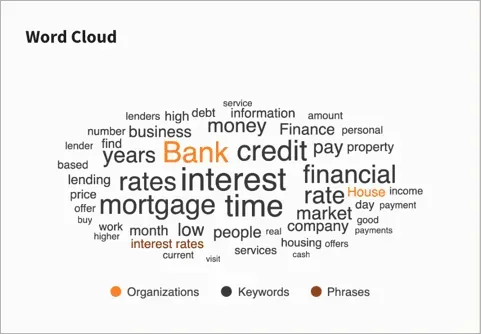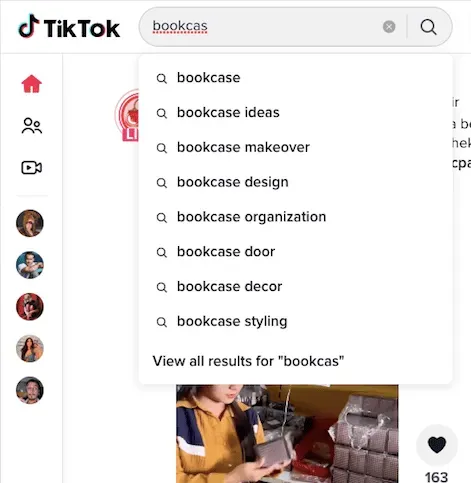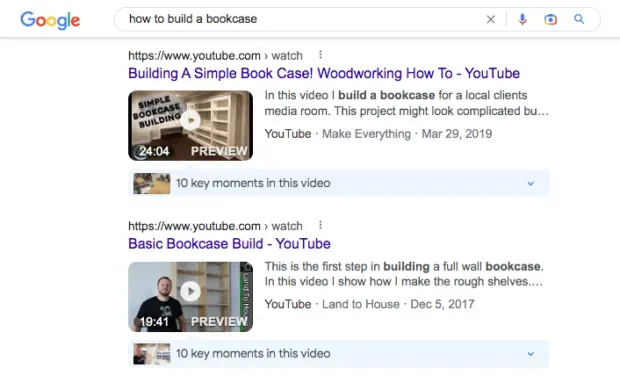Do you rely on social media algorithms to get your content seen (i.e. post and hope for the best)?
If so, you may be missing new subscribers and leads. Social SEO helps your content get seen by people who are actively looking for companies like yours or the products and services you offer.
Read on to find out what social media SEO means, why it’s important, and most importantly, how it can help you grow your social media business accounts.
Social SEO is the art of adding text features like captions, alt text, and close captions to your posts so that people using search bars on social platforms can easily find your content.
To understand social SEO, you need to understand the basics of traditional SEO.
In digital marketing, SEO stands for search engine optimization. Social networks are not technically search engines, but they all have search bars. Social platforms are increasingly incorporating the features of traditional search engines to help users match the content they want to find.
Search engines like Google or Bing allow you to search for information and then display a list of web results that point to the content you’re looking for. (Or at least the content algorithms think what you would like to see based on the search phrase you use, your location, previous searches, etc.)
Search engines use their own set of ranking signals. These signals determine which results, out of all the content available on the Internet, are most likely to tell you what you want to know.
Initially, people used social media to view content from specific people and brands they wanted to follow. Now people actively use social networks to search for specific information. Think product reviews, brand recommendations, and local businesses worth visiting.
Social SEO is all about getting noticed when people are actively searching for content, not scrolling through their feeds.
Social SEO Tips for Every Network
Here’s what you need to know to get your content found on all social media.
Instagram SEO Tips
- Optimize the SEO of your Instagram profile. Use keywords in your name, screen name, and bio, and include a location if needed.
- Include relevant keywords and hashtags in the title. Hiding hashtags in comments no longer works. Keywords in the title help your content appear on keyword search pages.
- Add alternative text. The main purpose of alt text is to make visual content more accessible. However, it does serve the added benefit of helping Instagram understand exactly what your content is so it can show it in response to relevant searches.
- Mark your location. This way, your content will appear on the new Instagram cards, which can function as a local business search.
To learn more about Instagram SEO strategies, check out the full post on our Instagram SEO blog.
TikTok SEO Tips
- Optimize the SEO of your TikTok profile. Add relevant keywords to your TikTok user profile to improve the SEO of your entire account.
- Double dip your main keyword into TikTok itself. Say out loud the main keyword for your TikTok in your video clip and turn on the text overlay on the screen. Saying your keyword out loud means it’s also included in the auto-generated subtitles, making it a triple flop.
- Include relevant keywords and hashtags in the title. By title here, we mean the description of the video, not speech titles (although you should also include your keywords there, as noted above). Focus on keywords rather than hashtags to improve SEO on TikTok.
YouTube SEO Tips
- Use your main passphrase as the video file name. For example, DIY-bookcase.mov
- Include your main keyword in the title. But use the longer version that people can type into a YouTube search bar, like “how to make a DIY bookcase”.
- Use keywords in your video description. Especially within the first two lines, which are visible without further pressing. Be sure to include the primary keyword and add one or two secondary keywords later in the description if you can do it in a way that doesn’t look like keyword stuffing.
- Say the keywords in the video and turn on the subtitles. Be sure to say the keywords out loud at some point in the video. Then turn on subtitles in YouTube Studio.
- Create educational videos. How-to videos get most of their views from search, while other types of videos get most of their views from home page, featured videos or playlists.
- Don’t worry about tags. YouTube says tags are not an important factor in searches. They are mainly used to fix common spelling errors such as DIY vs DYI.
Facebook SEO Tips
- Optimize the SEO of your Facebook page. Use your primary keyword in the page title and friendly URL, about us section, and description.
- Add your work address to your profile. If relevant, this will allow your page to be included in local searches.
- Add location pages for different locations. If you have multiple stores and offices, add a location page for each store or office to increase their chances of appearing in local searches.
- Include relevant keywords in your posts. Using natural-sounding language, be sure to include the most relevant keyword in each post and photo caption.
Twitter SEO Tips
- Optimize the SEO of your Twitter profile. Use your primary keyword in your name, nickname, and bio on Twitter.
- Include relevant keywords and hashtags in your posts. You don’t have many characters to work with, so use your keywords wisely. Incorporate them naturally into your post so that your post continues to be valuable to readers.
- Add alternative text. If you’re including images in your tweet, add alt text that includes your keywords (if it’s relevant to the image – remember that the main purpose of alt text is to make content accessible to the visually impaired). Do this by clicking Add description below the image when you create the tweet.
Pinterest SEO Tips
- Optimize the SEO of your Pinterest profile. Use the main keyword in the username and in the “About Us”section.
- Create boards based on your main keywords. When setting up your account structure, use your primary keywords to guide the boards you create and name them accordingly.
- Use long-tail keywords in your Pin titles. Create pins around long-tail keywords like “How to build a DIY bookcase”rather than “DIY bookcase”or even “Build a DIY bookcase.”
- Include keywords in the description. Write a description that sounds informative, not just a list of keywords. (Remember, you want people to actually click on the Pin, which they won’t do if they’re disabled by the description.) But include relevant keywords in a natural way that matches the Pin’s title.
- Use high quality images to take advantage of visual search. Pinterest Lens allows users to search using the camera instead of the keyboard. High-quality, relevant images ensure you don’t miss those searches.
LinkedIn SEO Tips
- Optimize the SEO of your LinkedIn page. Include the most relevant keyword in your Page slogan and About Us section.
- Create rich content based on relevant keywords. LinkedIn articles give you breathing space to create valuable content based on important keyword clusters.
- Do not overdo it. Linked-In immediately categorizes content as spam, low quality, or high quality. If you stuff your post with too many keywords or hashtags, guess where it will go? Not in the top search results. Include keywords naturally (not stuffed) and only include really relevant hashtags.
1. Get your content seen
In the past, in order to see your social content, you had to work with algorithms to get your content into people’s feed. People are now taking a more proactive approach to finding the content they want, rather than just scrolling through the content presented to them.
Thus, the emphasis on detectability is not new. Social SEO simply requires a change of mind about how people find out about your content. When people search on social platforms, you want them to find your content.
2. Grow your social channels faster
Social SEO is talking to people who are not (yet) following you on social platforms. This means it can be a more effective way to grow your social channels than focusing solely on algorithms. New eyeballs are the key to growth.
3. Attract potential customers who don’t use traditional search engines
This summer, Instagram launched a new searchable map feature that allows people to find popular places using the app. Instagram is now directly competing with Google Maps to be the best search results provider for local businesses.
New card, who is it? 🌐🗺️
Now you can find popular places near you or filter by categories like cafes or beauty salons. pic.twitter.com/asQR4MfljC
— Instagram (@instagram) July 19, 2022
Teen writer Julia Moon said in an article for Slate:
“I regularly use Google products. But I only use them for the most basic tasks: spell checking something, quick fact finding, looking up directions. If I’m looking for a place to dine, a cool new pop-up, or an activity my friends will love, I won’t bother with Google.”
Her favorite local search map is Snap Maps.
And high school student Jacobi Moore told The New York Times that she used a TikTok search to learn how to request a teacher’s letter of recommendation when applying to a public school.
No matter what product or service your company sells, there is a potential customer base that will never find you through traditional search engines. Social SEO is your key to connecting with this audience.
How is SEO used in social media?
Social SEO is the practice of including relevant information and keywords in your posts (in captions, alt text, subtitles, and close captions) to increase the chances of your content appearing among users browsing social media.
Social media SEO works the same as SEO on traditional search engines. It all starts with keyword research. So far, we’ve talked a lot about using keywords. But how do you find the right keywords to use?
Instead of coming up with your own keywords based on how you think people will search for your content, you need to understand how people actually search for content like yours.

Source: Hootsuite Insights word cloud powered by Brandwatch.
Here are some good tools to get you started:
- Google Analytics: This tool can show you which keywords are already driving traffic to your site. While you can’t assume that the exact same keywords will work for your social content, they are a good starting point.
- Hootsuite Insights by Brandwatch: In this tool, you can use the word cloud feature to find what words are commonly used in relation to your brand or industry. Again, this is a good starting point for testing.
- SEM Rush Keyword Magic Tool: Enter a keyword related to your content and this tool will generate a list of additional keyword and phrase suggestions.
- Google Trends: Enter a search term and you’ll get a graph of interest over time and by region, as well as suggestions for related topics and related queries. Specifically for YouTube data, change the drop-down menu from web search to YouTube search.
- Hootsuite: Set up social media listening streams in Hootsuite and keep an eye on the common language used in discussions about your product, brand, industry, or specific niche.
- Search bar for each social network: On each social network, start typing a keyword and see what auto-complete options are offered.

Source: Finding Keyword Inspiration Using TikTok Search.
Which social media platform is best for SEO?
All social platforms offer slightly different options for using SEO techniques. So which is better?
This question is difficult to answer because the network that is most important to focus your search engine optimization efforts on is the one where your audience is most likely to spend their time or do their research. To answer this question, you need to do some basic audience research.
But in terms of SEO functionality, YouTube is definitely the social platform that is most like a search engine. This is not surprising since YouTube is a product of Google.
Looking at social SEO from a different perspective, if you’re hoping your social content will show up in Google search results, YouTube wins again.
Besides, it depends. The partnership between Twitter and Google allows tweets to feature prominently in search results. Pinterest ranks well for visual content. LinkedIn pages often appear in business search, and Facebook pages rank particularly well for local businesses. Google is currently working on improving its ability to index and serve TikTok and Instagram video results.

Source: YouTube video in Google search results
How is SEO different from social algorithms?
Social algorithms are designed to provide content to people who are passively browsing or scrolling through a social feed, such as a TikTok For You page. SEO, on the other hand, focuses on getting your content visible when people are actively searching.


